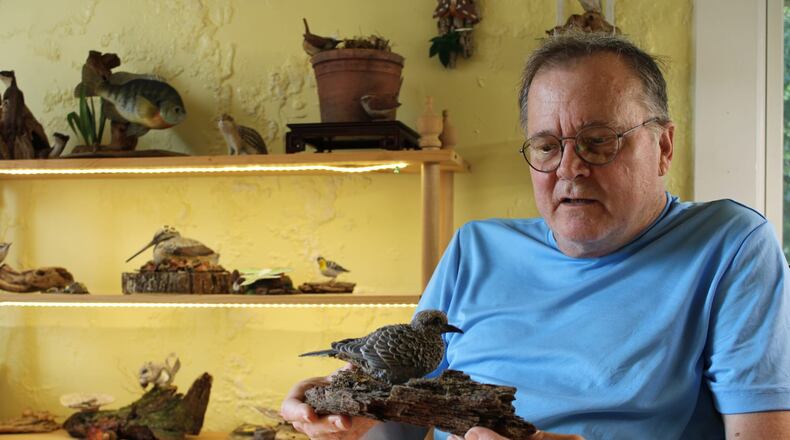“I’ve always done it around the edges of my life,” Bartel said. “I studied it formally in undergrad but have not ever tried to pursue it as a full-time career, so I’m still making my way. It’s always been my heart’s desire, and I just never let myself really try.”
Bartel was a teacher by profession before making the jump to art full-time. Now, she designs fabrics, does digital illustrations and sews — all from her studio in the Oxford Community Arts Center (OCAC).
The OCAC has rented out rooms on its third floor to artists for 20 years, and Bartel became one of the resident artists five years ago. She’s there at least three days a week now, and she says the space has been essential to her process.
“It gives me a place to come every day to work that is not my home ... When everything happens under the same roof, it’s hard to separate them out, and it’s hard to be productive,” Bartel said. “[My studio] helps me to separate my personal life from the business I’m trying to build. It gives me a place to focus on that.”
OCAC’s in-demand studio space
Heidi Schiller, executive director of OCAC, said the resident artist program works in part because of the building’s history. The center was originally built as a women’s college, the Oxford Female Institute, and the second and third floors used to be dorms for students.
The OCAC signed a 50-year lease for the building in 2001, and after years of renovations, the artist studios opened in 2004 with 17 artists, four of whom still rent space today. Today, that number has swelled to 30 resident artists and a waitlist that’s 22 people long.
“We just had a new person come in, and she’s been on the waitlist for three years,” Schiller said. “We’ve had Miami students who put their name on the waitlist when they were freshmen and never got in.”
Those waitlisted artists could make it into the building in the next few years with OCAC’s planned renovations on the horizon. Schiller said they’re early in the process of conceptual design which would bring air conditioning to all four floors of the building and convert storage rooms on the second floor into more studios, among other changes. After the design phase, the nonprofit will need to raise money to complete the renovations.
The current resident artists include writers, musicians, photographers, fiber artists, sculptors and more. Schiller said many of them are actively marketing their art, and some even sell their work in the OCAC building itself. Right now, the average studio rents for $110 per month.
“We run the gamut ... They’re all kinds of disciplines,” Schiller said. “It’s not just people who are painting.”
A community for hobbyists and professionals alike
OCAC’s resident artists decorate their doors and leave art for sale in the third floor hallways. While the space can get stifling in the summer without air conditioning, it’s also alive with color year-round, especially during OCAC’s Second Friday celebrations.
On the second Friday of each month, OCAC holds a celebration to launch its newest gallery collections, complete with musical performances. Resident artists are encouraged to attend and keep their doors open for patrons to visit the third floor and chat.
Mike Wright has rented studio space with OCAC for 12-15 years. The retired Miami University biology instructor uses polymer clay to create lifelike sculptures of animals and characters. He said it’s hard to part with his work sometimes, but he does donate to OCAC’s auctions and sells items occasionally, and he tries to make it to each Second Friday celebration.
“I really enjoy them,” Wright said. “They kind of have a varying amount of attendance, depending on the weather ... It’s a mixture often of people that have been coming to these things for years, I’ll see the same people ... and then it’s new people. It’s been really favorable, that’s part of the fun of it, just getting to meet new people.”
Mike Wright has used his studio in the OCAC building for more than a decade to make lifelike animal sculptures out of polymer clay. Photo by Sean Scott
Patrons may also be treated to live music from the resident artists upstairs during Second Fridays. At the July 12 celebration, Joe Prescher, a visual artist, set up with his guitar to play while people mingled throughout the third floor.
Watercolor artist Elizabeth Brice, who has rented her studio since the second year OCAC offered the program, said the studios fill a need for space for community artists. Having a dedicated space for art helps Brice feel productive, as does the sense of belonging with dozens of other artists.
“I feel like we have a community of artists here,” Brice said. “Most of us are not professional artists. We’re hobbyists, but it’s a really good group of people ... We have a gathering once a month of people ... just to kind of chat and share what we’re doing.”
Elizabeth Brice uses her studio for watercolor painting (left). Joe Prescher plays guitar during a Second Friday event (center). OCAC’s resident artists fill the third floor hallway with their work (right). Photos by Sean Scott
As Bartel continues to manage her transition into life as a full-time artist, she said that sense of community the OCAC provides has been essential.
“It encourages me to keep going, keep showing up, keep trying,” Bartel said. “Every month there’s a little bit of accountability, because if I’m in town, I’m here for Second Friday. My door is open and I’m showing people what I’ve done, and hopefully I have something new to show you.”
This article was originally published by the Oxford Free Press, a content partner of the Journal-News. See it online at oxfreepress.com.
About the Author

